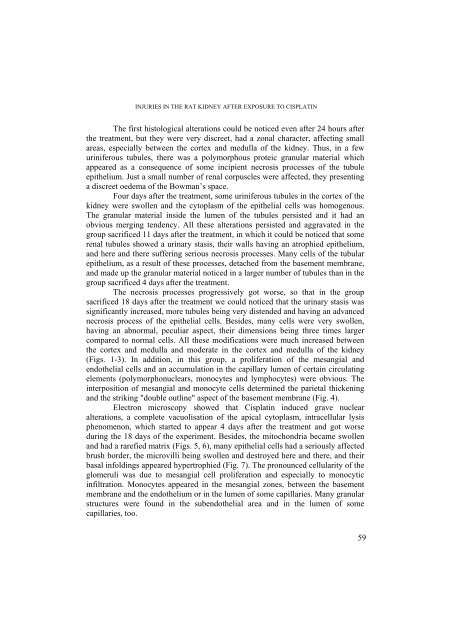studia universitatis babeÅ-bolyai biologia 2
studia universitatis babeÅ-bolyai biologia 2
studia universitatis babeÅ-bolyai biologia 2
You also want an ePaper? Increase the reach of your titles
YUMPU automatically turns print PDFs into web optimized ePapers that Google loves.
INJURIES IN THE RAT KIDNEY AFTER EXPOSURE TO CISPLATIN<br />
The first histological alterations could be noticed even after 24 hours after<br />
the treatment, but they were very discreet, had a zonal character, affecting small<br />
areas, especially between the cortex and medulla of the kidney. Thus, in a few<br />
uriniferous tubules, there was a polymorphous proteic granular material which<br />
appeared as a consequence of some incipient necrosis processes of the tubule<br />
epithelium. Just a small number of renal corpuscles were affected, they presenting<br />
a discreet oedema of the Bowman’s space.<br />
Four days after the treatment, some uriniferous tubules in the cortex of the<br />
kidney were swollen and the cytoplasm of the epithelial cells was homogenous.<br />
The granular material inside the lumen of the tubules persisted and it had an<br />
obvious merging tendency. All these alterations persisted and aggravated in the<br />
group sacrificed 11 days after the treatment, in which it could be noticed that some<br />
renal tubules showed a urinary stasis, their walls having an atrophied epithelium,<br />
and here and there suffering serious necrosis processes. Many cells of the tubular<br />
epithelium, as a result of these processes, detached from the basement membrane,<br />
and made up the granular material noticed in a larger number of tubules than in the<br />
group sacrificed 4 days after the treatment.<br />
The necrosis processes progressively got worse, so that in the group<br />
sacrificed 18 days after the treatment we could noticed that the urinary stasis was<br />
significantly increased, more tubules being very distended and having an advanced<br />
necrosis process of the epithelial cells. Besides, many cells were very swollen,<br />
having an abnormal, peculiar aspect, their dimensions being three times larger<br />
compared to normal cells. All these modifications were much increased between<br />
the cortex and medulla and moderate in the cortex and medulla of the kidney<br />
(Figs. 1-3). In addition, in this group, a proliferation of the mesangial and<br />
endothelial cells and an accumulation in the capillary lumen of certain circulating<br />
elements (polymorphonuclears, monocytes and lymphocytes) were obvious. The<br />
interposition of mesangial and monocyte cells determined the parietal thickening<br />
and the striking "double outline" aspect of the basement membrane (Fig. 4).<br />
Electron microscopy showed that Cisplatin induced grave nuclear<br />
alterations, a complete vacuolisation of the apical cytoplasm, intracellular lysis<br />
phenomenon, which started to appear 4 days after the treatment and got worse<br />
during the 18 days of the experiment. Besides, the mitochondria became swollen<br />
and had a rarefied matrix (Figs. 5, 6), many epithelial cells had a seriously affected<br />
brush border, the microvilli being swollen and destroyed here and there, and their<br />
basal infoldings appeared hypertrophied (Fig. 7). The pronounced cellularity of the<br />
glomeruli was due to mesangial cell proliferation and especially to monocytic<br />
infiltration. Monocytes appeared in the mesangial zones, between the basement<br />
membrane and the endothelium or in the lumen of some capillaries. Many granular<br />
structures were found in the subendothelial area and in the lumen of some<br />
capillaries, too.<br />
59

















